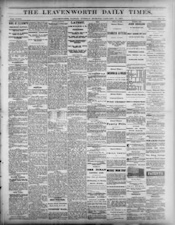Daily Times [Leavenworth, KS], November 3, 1860
[Correspondence of the Times.]
Fort Washita, C. N.,}
Oct. 22, 1860. }
. . . When near the Southern boundary of Kansas, we met a large party of the Osage tribe on their return from the buffalo hunt, having laid in a large quantity of their favorite meat. Leaving the Osage country, we came into the Cherokee Nation, where settlements are quite numerous. The crops (especially corn) look remarkably well, and are the best we have seen this summer. The drouth don’t appear to have been so severe here as in Kansas.—We did not see a running stream of water after leaving Fort Riley, until we arrived at the Grand, or Neosho river, and this was very low, not having over twelve inches of water in its channel. Even the Virdigris was dry as a bone. From Grand river to Fort Smith, we marched through one continual stretch of timber. When evening approached we turned off the road and encamped by the side of some little mountain stream, tying our horses to trees, and giving them their four quarts of corn per day, on which they had to travel from twenty-five to thirty miles a day. We passed through Tallequah, the Capitol of the Cherokee Nation, a beautiful little village of about three hundred inhabitants, and completely surrounded by woods. I have noticed that all villages built by Indians, whether civilized or not, are invariably located in some secluded, but generally romantic spot.
We arrived at Fort Smith on the 19th of September, where we were disposed of as follows: Companies E and D, 3d Squadron, under command of Capt. Sturgis, to remain at Fort Smith, to assist the Cherokee Indian Agent in removing unlawful settlers upon the lands of the Cherokees, out of the Nation, should it require force to expel them therefrom. The remainder, companies B and A, 1st Squadron, under command of Capt. W. N. R. Beale, to proceed to Fort Arbuckle, where they were stationed last winter; and Companies C and I, 2nd Squadron, under command of Capt. C. A. Caw, to proceed to Fort Washita, where they were stationed last winter.
The Arkansas river is very low at present—only fourteen inches of water in the channel. Navigation to Fort Smith has been suspended since last May. Steamboats can now run up only as far as Little Rock, where all the government stores to supply Forts Smith, Washita, Arbuckle and Cobb, are unloaded, and from there transported, by government trains, to Fort Smith, to be again transported from there to the different forts above mentioned, as necessity requires them.
The 1st Squadron remained at Fort Smith eight days, and then proceeded homewards, where I learn they arrived after a journey of twelve days.
The 2nd Squadron remained fifteen days, to give the horses time to recruit up, they having been nearly used up in marching through the timbered country north of the Arkansas river. On the 3d of October, the 2nd Squadron took up the line of march for this place, where it arrived on the 11th inst., having been on the plains six months and two days, during which time we traveled 126 days, and laid over 47 days; traveling 2419 miles, making an average of 19¾ miles for each marching day, or 13 1/5 miles for each day on the plains. This is the longest trip the First Regiment of Cavalry has made since its organization in 1855.
The weather here is very pleasant, and the troops in good health.
Rover.
